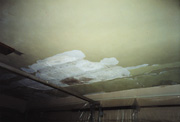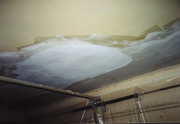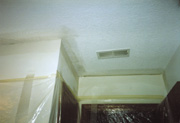

This time around I wanted to spend some time discussing textures. If the repaired surface is not smooth, then texturing is necessary. Matching and blending the repaired area with the existing area that surrounds it is a true art. Let's look at two examples. I'll use the PATCH system to evaluate the first repair.

What's the problem here?
Problem:Inphoto #1you'll notice damage that occurred due to ice damming in the garage. On this ceiling USG Rocklath was installed with basecoat and a random float finish made from lime, Keenes cement and river sand. The water caused a separation between the finish coat and the basecoat.Approach: The board itself was quite solid and in good shape, so the removal involved parts of the basecoat and finish. In photo #2, I applied bonder to the affected area and extended the application of it a good foot beyond what I was actually repairing. This allowed me to feather and blend the repair into the existing ceiling. The next step involved applying a layer of basecoat (Kal-Kote Basecoat from National Gypsum and USG's Diamond Basecoat are two brands I frequently use) over the entire area and then I embedded heavy fiberglass mesh into the basecoat. In photo #3 you'll see that I then applied another thick layer of basecoat over the entire area.
Because this ceiling had such a rough random float finish, I was able to work this repair in a way that's different from what I usually do. Usually I feather in the edges of the basecoat and then allow it to set up completely. I apply a sand finish over the basecoat and floated it to match the ceiling. However, in this case, I was able to finish out the basecoat. I began by feathering the edge around the perimeter of the repair and then running a very wet sponge across all the basecoat, combing it down and making it all a uniform level. As brown spots in the basecoat started to appear, I went back and random floated the entire area. The texture matched perfectly with the existing ceiling.
Time: It took about an hour and a half for set-up and scraping the ceiling. I then cleaned up the area and was ready to bond the ceiling. Bonding the ceiling took about 15 minutes. After I bonded the ceiling, I waited about an hour before beginning the basecoat (while the bonder was drying I did a small repair inside the house). From the time I began applying the basecoat until I finished took about another hour and a half to complete.
Cost: Originally my estimate was somewhere in the $975 range. This included the repair inside the house and the garage work. However, the couple called me back and asked if I would do the work less their $250 deductible. The insurance company was cutting a check for $725. I agreed and did the job. However, I would like to relate a story that might explain my stance on pricing.

Surviving the game
There was a boy who was made fun of for years in a small town. One day a salesman came through and the town folk wanted to show him off. They brought the little boy in and showed the salesman how they tricked him. One of the men in the coffee shop held out a nickel and a dime in front of him. "Now Billy, which one do you want, the little dime or the big nickel?" he asked. Without answering, Billy grabbed the nickel and ran out of the shop. Everyone broke out laughing. Everyone except the salesman. He didn't find it very funny. So he went outside and found Billy."Billy, I want to help you. For all these years these men have been making fun of you." The man then took out a dime and nickel from his pocket. "Billy, even though this dime is smaller than the nickel, it's worth two nickels."
"I know that," Billy said without hesitation.
"You do?" asked the surprised salesman. "Then Billy, why do you keep taking the nickel?"
"Because if I took the dime, they'd stop playing the game!" said the smart little boy.
How: How did the job work out? Very well. The homeowner was happy with the job, the insurance company was happy getting the claim settled, and I was happy both in getting paid and in being able to put this garage area back together. How was the proposal originally laid out? I gave them two options: repair or resurface. I leaned more toward repair here because the homeowner was more concerned with getting it done so there wouldn't be loose plaster falling on his car. And he was not as concerned with its being perfect. If he was in any way expecting the most perfect of jobs, then I would have insisted on resurfacing. Making sure the customer is going to be happy with the end result is the key here.
Example 2 is what we're running into more and more these days: drywall finished homes. In photo #4 you will see a bathroom where a crack started to appear and open up between the wall and ceiling area. In the past I would have avoided this type of repair, simply because I didn't get into the splatter texture and acoustical popcorn-type finishes. I stuck mainly to plaster repair. However, that all changed recently when Jay Boswell from Spraytex introduced me to its line of spray textures. Take a look at photo #5. Here I have used plaster to do the initial repair. I cut out the damaged paper tape and then used lime and molding plaster to repair the area, with mesh tape being embedded into the angle. The wall was smooth finish, so I needed only to apply some splatter texture to the ceiling along the edge. This I sprayed on and then knocked down with a margin trowel. It blended in perfectly.
Until next time, keep in touch and let me know about the projects you're working on. Take care!

Report Abusive Comment